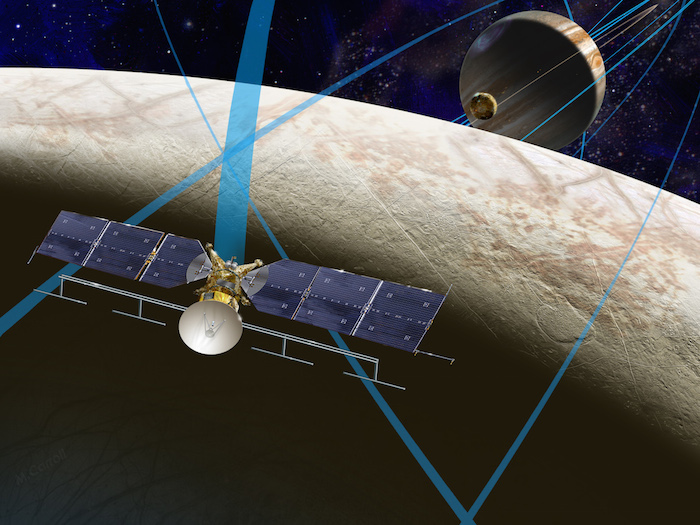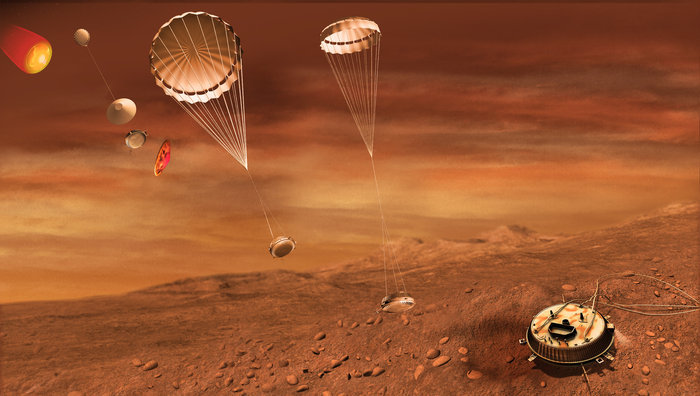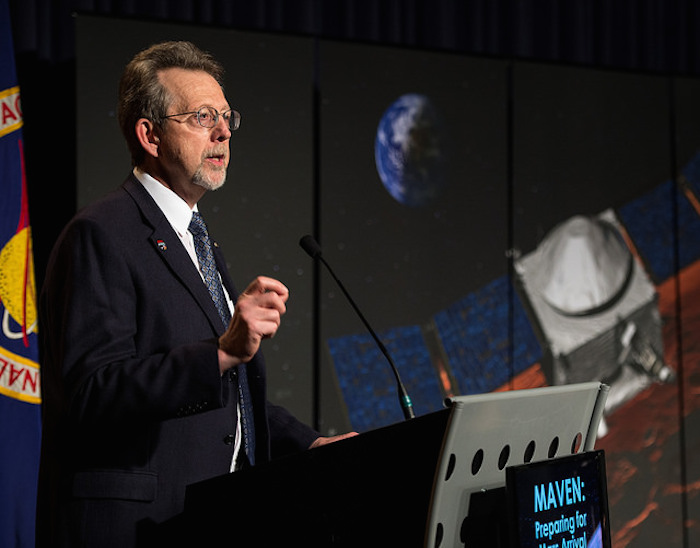.
11.04.2015

Artist’s concept of the Europa Clipper spacecraft. Credit: NASA/JPL-Caltech
.
After walking away from a previously planned joint mission to Jupiter, NASA has asked the European Space Agency if it can furnish a lander or ice-penetrating probe for a rejuvenated U.S.-led robotic spacecraft to visit Jupiter’s moon Europa.
NASA’s mission to Europa is scheduled to launch in the mid-2020s to begin a multi-year journey to Jupiter. Once it arrives, the probe will loop into an ever-changing orbit carrying it past Europa dozens of times.
Engineers and scientists at NASA’s Jet Propulsion Laboratory have worked on a design that will likely form the foundation of the mission. Called Europa Clipper, the mission would conduct 45 flybys of Europa in the late 2020s and early 2030s.
The Europa mission has fresh life after winning support from the White House earlier this year, and NASA plans to formally begin development of the spacecraft as soon as mid-2015. The milestone will put the mission beyond a gate no other Europa probe concept has ever passed, despite multiple iterations of concepts and plans left on the shelf after redesigns and funding woes.
NASA settled on a Europe flyby mission after deeming an orbiter or heavily-instrumented lander too expensive for the U.S. budget, but officials have not given up deploying a barebones probe to Europa’s surface.
One outcome of NASA’s engagement with ESA could be a mission similar to Cassini-Huygens, which included a U.S.-built Saturn orbiter and a European lander that descended to the gas giant’s methane-shrouded moon Titan.
“We’re trying to recreate some of the excitement we had at Saturn and Titan with one of our most valued partners,” said Jim Green, manager of NASA’s planetary science division.
In an interview at the Lunar and Planetary Science Conference in March, Green said NASA requested ESA examine whether it has the interest and the funding to contribute something to the Europa mission.
.

Artist’s concept of ESA’s Huygens lander, which descended to Titan’s surface in January 2005. Credit: ESA-C. Carreau
“It could be a lander, it could be a penetrator, or it could be a probe to fly through the plumes,” Green said, referring to supposed detections of watery eruptions from Europa’s icy crust. “These are the things we have asked ESA to look at.”
Europa is encased in a thick global ice shelf floating on an underground ocean of liquid water, and Jupiter’s fourth-largest moon is a prime location for scientists looking for extraterrestrial life in the solar system. Researchers say they have found evidence for scattered lakes just below Europa’s frozen crust, and closer to life-supporting nutrients.
A dedicated mission to Europa could survey the ice sheet, map its fractures and locate vents that expose the underground salt water reservoir to space.
Any addition to NASA’s Europa mission’s will make the spacecraft heavier, but engineers have not finalized the craft’s official design, so officials said it is too soon to know how a piggyback probe could impact the mission’s launcher and trajectory to Jupiter.
The Europa Clipper concept’s development schedule could have the mission ready for launch by June 2022, said Barry Goldstein, the Europa Clipper pre-project manager at JPL. Engineers have examined launching the mission on NASA’s new heavy-lift Space Launch System or on the most powerful version of the Atlas 5 rocket.
Fabio Favata, head of ESA’s science planning and community coordination office, said an internal assessment is underway to determine if a Europa piggyback probe is feasible within the agency’s medium-class mission line. The last medium-class mission approved by ESA, the exoplanet-hunting Plato telescope, had a cost cap of 600 million euros, or about $635 million.
“What we have done is to have a very simple look at what kind of possible collaboration scenarios could one realistically implement, supposing we were to take a medium mission funding slot,” Favata said in an April 8 interview. “Could we do something? What would be the possible technical mission profiles?”
.

Artist’s concept of ESA’s Jupiter Icy Moons Explorer mission set for launch in 2022. Credit: ESA
.
ESA divides its robotic science missions into small, medium and large segments. Favata said the agency should pick finalists for its next medium-class science project — the M4 mission — in June after analyzing proposals submitted by research teams across Europe.
Once ESA managers decide which proposal will go forward — and how much it will cost — officials can plan when to start the next medium-class mission competition. If ESA concludes it is interested in partnering with NASA on the Europa mission, scientists could present concepts in the selection round for Europe’s M5 mission, according to Favata.
“What will we do is to make the result of this internal study available publicly, and then if and when there is a suitable call for missions, if some members of the community are interested in having a look at this and using it as a basis for a proposal, it gives them a realistic starting point,” Favata said. “Nothing would prevent anybody from saying, ‘We would still like to go to Europa with NASA, but we don’t like what you guys have been talking about, or we don’t believe this is the right mission scenario,’ and propose something completely different. This would be evaluated without prejudice.”
Favata stressed it will be up to European scientists to decide whether a Europa probe is worth proposing, but he said any contribution will likely be in the form of a structural component — like a secondary spacecraft — rather than scientific instruments.
“ESA doesn’t decide on missions in smoke-filled rooms,” Favata said. “As for any ESA mission, it is something which comes from an open call for missions or an open call for proposals. Assuming scientists find it interesting, they will respond.”
The current trans-Atlantic discussions on the Europa mission come four years after NASA opted to prioritize a new Mars rover over a joint U.S.-European project that would have dispatched two spacecraft to Jupiter in 2020.
.

Jim Green, director of NASA’s planetary science division. Credit: NASA/Bill Ingalls
NASA followed the recommendations of a “decadal survey” by the National Research Council, which urged the space agency to begin work on a series of missions to return soil samples from Mars to Earth. The new Mars lander is based on the design of the Curiosity rover now on the red planet, and it is scheduled for launch in 2020 with a suite of science experiments and equipment to collect and store samples for retrieval by a later mission.
The U.S. withdrew from plans to launch the tandem mission to Jupiter in 2020, leading ESA to draw up its own spacecraft named the Jupiter Icy Moons Explorer, or JUICE.
The JUICE mission will depart Earth, head off on an eight-year cruise to Jupiter, and eventually drop into orbit around the planet’s largest moon, Ganymede, which harbors its own ice-covered ocean.
With NASA’s commitment to a Europa mission, it again appears two spacecraft will be touring the moons of Jupiter simultaneously.
As European Space Agency managers mull over NASA’s invitation to build a Europa lander or impactor, scientists continue working on the JUICE mission, which is committed to a 2022 launch date.
“Clearly, we are going to the Jupiter system with the JUICE mission, so there is an obvious scientific interest in Europe,” Favata said. “Therefore, if NASA decides to implement the Europa Clipper mission, there is possible interest in Europe about being part of that and participating or collaborating.”
“ESA has really been our best partner,” Green said. “They’ve been fabulous working with us. We’ve had ups and downs in the past, and all seems to be forgiven. We’re right back together, and I want to give them an opportunity to be part of this mission. We shouldn’t let that go, and we have to let that evolve.”
NASA expects to announce a list of candidate science instruments that could fly on the Europa flyby craft in the coming weeks, with final selections due next year.
“I believe the end result over the next year — as these things happen — is we’re going to be prouder and prouder of what we’re going to be able to do at Europa,” Green said.
Quelle: SN
.
Update: 27.05.2015
.
THESE 9 INSTRUMENTS WILL FIND OUT WHETHER ALIENS COULD LIVE ON EUROPA
FIGURING OUT IF CONDITIONS ARE RIGHT FOR LIFE ON JUPITER'S ICY MOON
.
At the beginning of the year, NASA got some exciting news from the Obama Administration: The space agency is finally getting funding to send a probe to Jupiter’s moon Europa by the mid-2020s. With a subsurface ocean suspected to be lingering underneath its icy crust, Europa is one of the top candidates in our solar system for finding extraterrestrial life. And NASA hopes its probe can figure out if conditions are right for little aliens to exist.
To do that, the space agency needs the right instruments to study the environment surrounding the icy moon. NASA’s proposed Europa Clipper mission won’t be landing on Europa but will be “clipping” the space rock, swooping into its atmosphere 45 times over the course of two-and-a-half years. During these flybys, the various instruments attached to the clipper probe will gather as much data as possible before the probe dips back out again.
NASA hopes to answer the biggest question of all: Is Europa habitable?
Today NASA announced just what these integral instruments will be. According to the agency, 33 different proposals were considered for the probe, which were ultimately narrowed down to nine. All the instruments will work in tandem to answer looming questions about Europa: How deep and salty is the ocean? How thick and active is the moon’s ice shell? What’s that brown gunk we see in all the Europa pictures?
The answers to these questions, NASA says, could help answer the biggest question of all: Is Europa habitable?
Unfortunately, none of the nine instruments are designed to detect life directly. According to Curt Niebur, Europa program scientist at NASA Headquarters, the scientists at NASA couldn’t decide on an instrument that could best measure something that significant. “What became clear is we don’t have a life detector,” said Neibur at a press conference. “We don’t have consensus in the scientific community what we’d measure to say that this thing you’re looking at is alive.” Some instruments do claim to detect signatures of life, though contact with the planet is necessary.
Check out the nine instruments below and why NASA says they deserve a ride aboard the Europa Clipper.
Interior Characterization of Europa using Magnetometry (ICEMAG): a magnetometer designed to measure the magnetic field of Europa. According to NASA, understanding the moon’s magnetosphere will be like taking an MRI of the interior structure of Europa.
Plasma Instrument for Magnetic Sounding (PIMS): This instrument works in conjunction with ICEMAG to measure the plasma currents surrounding Europa. This could help the space agency get a better understanding of Europa's ocean depth, its salinity, and a heavily debated topic in the scientific community--the thickness of the moon's ice crust.
Mapping Imaging Spectrometer for Europa (MISE): An infrared spectrometer that measures the spectra (those squiggly lines) on Europa's surface. Spectra lines act like unique fingerprints, indicating the materials that have been on Europa's surface. One particular area of interest for NASA is figuring out what those lines of brown gunk are made of. These brown areas are associated with the youngest areas on Europa's surface, which means they could be material that have recently erupted up from underneath the ice.
Europa Imaging System (EIS): NASA is hoping to get some amazing photos of Europa's surface by equipping their probe with both a wide and narrow angle camera. Together, they'll snap images of the moon at 164-foot resolution, getting super high-res pictures of the various ridges and unique surface features of Europa.
Radar for Europa Assessment and Sounding: Ocean to Near-surface (REASON): Ice penetrating radar for looking at the structures underneath the ice crust. This will give NASA a better idea of how structures underneath the ice have changed through time. There is also strong evidence to support the presence of lakes within the ice shelves, close to the crust's surface, and this radar will help verify if they exist.
Europa Thermal Emission Imaging System (E-THEMIS): A thermal imager for detecting heat. This instrument will find the "hot spots" on Europa, which may indicate where the moon is most active. By hot spots, NASA means places that are slightly higher than Europa's average temperature of -260 degrees Fahrenheit.
MAss SPectrometer for Planetary EXploration/Europa (MASPEX): This mass spectrometer will analyze Europa's atmosphere. The materials found in the space above the moon will serve as a good indication of the materials that can be found on the surface and in the subsurface ocean.
Ultraviolet Spectrograph/Europa (UVS): NASA is really interested in the possibility of plumes living on Europa. Recently the Hubble Space Telescope spied water vapor above one of the moon's poles, indicating the presence of these vents. The spectrograph will use ultraviolet light to hunt down these plumes and identify how active they are.
SUrface Dust Mass Analyzer (SUDA): The dust analyzer will work similarly to the mass spectrometer, measuring the particles ejected from the plumes identified by the spectrograph.
Quelle:PS
6179 Views
